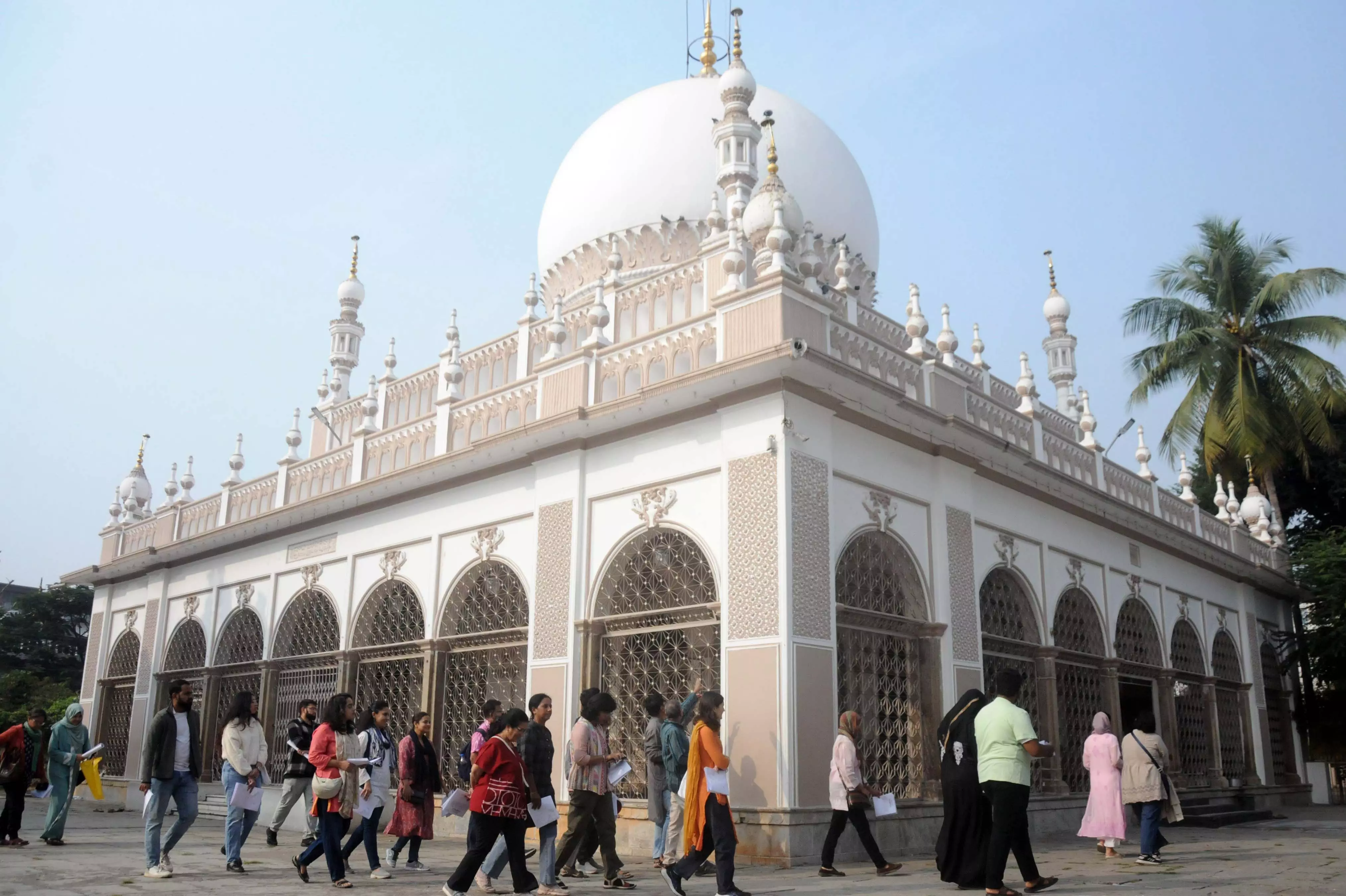Old maps trace Nampally’s Sufi heritage

Hyderabad: A visit to Nampally can easily transform into a spiritual sojourn, thanks to the prominent personalities who lie in rest there. Visitors often bow their heads in reverence at the shrines of Sufi saints that dot both the busiest and quietest lanes of this historic neighbourhood. Unbeknownst to many, they may also pass by the graves of some of Hyderabad’s renowned Urdu poets.
The Deccan Archive Foundation (TDAF) hosted its final map walk of the season on Sunday, offering new and old Hyderabadis a unique exploration of these lanes using century-old maps. Sibghatullah Khan, architect and founder of TDAF, led the participants to six significant sites, showcasing rare dargahs and shrines.
The walk commenced with the dargah of Hazrat Shah Khamosh, which houses the tomb of a revered saint from Bidar known for taking a vow of silence for 25 years. The blend of Islamic and Gothic architecture of the tomb with a massive dome is a reflection of the architectural trends in the late nineteenth century.
"The saint got his name as 'khamosh' when a fellow brother of his khankah (hospice) in Bidar commanded him "Tum Khamosh Ho Jaao!" to resolve a slight disagreement between them. After that the saint did not speak for 25 years. He only broke his vow when the same fellow who gave the command went down a stepwell and said “I won't come out until you speak to me," said Sibghatullah Khan.
The saint's vow of silence resonates with the Sufi principle of giving up worldly desires and bodily pleasures, where he had the inner strength of relinquishing the enjoyment of speech or utterance as well.
"Sufi, the word comes from the rugged woolen blanket called 'suf' that the saints would wear on their backs as they could not afford proper clothes. This harsh reality of Sufis is in extreme contrast with the imagery of a dervish wearing fine white garments with a Faiz cap and twirling in divine trance," Sibghatullah Khan explained.
The complex is significant for another reason: it houses the graves of two popular Hyderabadi poets. One of them is Makhdoom Mohiuddin, to whom the popular Bollywood songs ‘Chameli Ke Mandve Ke Tale’ and ‘Phir Chhidi Raat Baat Phoolon Ki’ can be attributed. His grave is overgrown with weeds and lacks any special markers to identify it as his. The graves of his wife and children alongside have unmarked graves.
The other poet, Amjad, is buried directly opposite in a walled enclosure adorned with flowers. During the 1908 floods, Amjad and his family were swept away by the water. He clung to a tamarind tree, which still stands today at Osmania General Hospital, saving the lives of more than a hundred people who clutched its branches alongside him. In his poetry, he later described the flood as "Qayamat-e-Soghra" (A Minor Doomsday).
The treatment of the two poets after their deaths contrasts starkly. Mohiuddin, a Marxist poet known for his critical stance against rulers and his association with leftist political parties, rests in a neglected, dilapidated grave. Meanwhile, Amjad's grave is well-maintained and adorned with flowers.
The next stop was the dargah Khitte Salaheen, where the graveyard houses graves from three prominent families: Baghdadi Shah, Aydroosi, and Salaheen. Among the notable individuals buried here is Ali Nawaz Jung, the Nizam's Chief Engineer. Another notable figure, whose family is buried here but not himself: General Al Edroos, the Commander-in-Chief of Hyderabad's army during the Indian government's takeover in 1948. The Al-Edroosi family, originally from Hadhramaut, Yemen, served the Nizams as military personnel.
The last chief, Syed Ahmed Al Aydroos, authored the book 'Hyderabad of the Seven Loaves', which offers his own account of Hyderabad's final days before integration into India. Although his family is buried here, his grave remains untraceable.
The walk concluded at the Dargah Aghapura, where the saint Shah Mohammed Hassan Abul Ulai is buried. His disciple, Agha Muhammad Dawood Abul Ulai, along with four others, rests at his feet. The complex includes a mosque, graveyards, the shrine, and a magnificent 'samakhana', which is illuminated annually on various occasions. The Bohemian and Turkish chandeliers, exquisitely preserved, bring an ethereal beauty to the place when lit.
"A samakhana is where qawwalis take place," Sibghat explained. "The celebration of Urs (the saint's death anniversary) includes qawwals reciting Sufi poetry, celebrating the idea of meeting God in heaven as a bride meets her groom."
